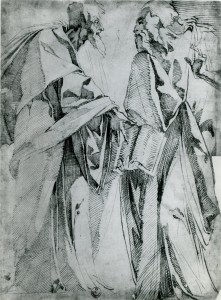1518 or early 1519 Florence, Uffizi, no. 6985F. Fig.D.2 Pen and ink, 37.2 x 27.5, a small strip missing at the right edge, and the lower right corner torn away; wm.? LITERATURE: Berenson, 1903, 1938, as Rosso. Becherucci, 1944, 26-27 (1949, 26-27), as Rosso, and close to the so-called Skeletons drawing and the Volterra Deposition. She also mentions its former attribution to Bandinelli. Barocchi, 1950, 194-195, Fig. 162, as Rosso a little before the Volterra Deposition and as showing the influence of Bandinelli. Longhi, 1951, 59 (1976, 99), as not by Rosso. Berenson, 1961, no. 2430C, as Rosso, and as inspired by Donatello’s bronze doors at S. Lorenzo. Pouncey, 1964, 290-291, as Rosso. Carroll, 1964 (1976), II, Bk. II, 476-477, F.24, 533-534, Bk. III, Fig. 173, as Bandinelli, ca. 1515; “Addition to the Preface,” 1976, vii, as a copy of a lost drawing by Rosso of ca. 1518. Formerly given to Bandinelli, correctly I thought, it is now kept under Giovanni Bandini at the Uffizi. After more extensive study, however, it seemed increasingly likely that the drawing is closely related to Rosso. His earliest generally accepted authentic pen drawing is the study in Vienna for the figure of Christ in the Borgo Sansepolcro Pietà (Fig.D.26A). In that drawing the handling of the small piece of drapery upon which the nude figure lies shows a refinement in the use of pen and ink that is compatible with the execution of the drapery under the right arm of the old man to the left of the Disputation Between Two Old Men. Elsewhere the handling of the pen in this drawing has a delicacy and accuracy that recalls the graphic handling of paint to define the drapery folds falling from the left arm of St. Jerome in the S. Maria Nuova Altarpiece. So while the draughtsmanship of the Uffizi drawing suggests Bandinelli’s and Bandini’s, it is more refined than the former’s and less regularized than the latter’s. Not actually identifiable with Bandinelli’s,1 only superficially does it resemble Bandini’s. The imagery along with the draughtsmanship is Rosso’s. The man at the left resembles, in spite of his beard, St. Jerome in the S. Maria Nuova Altarpiece of 1518 (Fig.P.5a), and both figures in the drawing can be related to two at the top of the Volterra Deposition (Fig.P.9a) and to the saints in the Villamagna Altarpiece (Fig.P.10a), both done in 1521. All of these works have a similar expressive vehemence that is found frequently in works by Rosso. The angular stances and gestures of the figures and their faceted drapery find close counterparts in the altarpiece of 1518 and in the two paintings of 1521. Furthermore, the drapery can be compared with that in Rosso’s red chalk Seated Woman in a Niche of 1524 (Fig.D.11). However, the drawing closest to the pen drawing is Rosso’s Study for an Altarpiece of around 1519 in the Uffizi (Fig.D.4). The figure of St. John in this black chalk drawing has a profile very much like those of the two men in the pen drawing. Furthermore, the saint’s pose, with the body seen from the front and the head in profile, is very much like that of the old man at the right. The draperies, too, are very similarly faceted, and there is a comparable juxtaposition and balance of lights and shades in both drawings. Conceptually and stylistically the two intensely disputing old men in the drawing suggest that the drawing was done around the time of the S. Maria Nuova Altarpiece of 1518. Its draughtsmanship even corresponds with the execution of that altarpiece. But the emotional temper and impulsive action of the two figures are more emphatic than what appears in the altarpiece, suggesting that the former might be slightly later. Therefore, it may date from 1518 or early 1519. It does not, however, show any of the Pontormesque characteristics of the Study for an Altarpiece done in 1519.
It is possible that the figures reflect knowledge of a disputation between Saints Paul and Peter in spite of the absence of their traditional symbols, the keys of the Church for Peter, a sword for Paul. Their appearances, with Paul the elder of the two and also the more demonstrative disputant, supports these identifications. Peter, at the right, holds open a large book to which Paul gestures, suggesting that their disputation is over biblical passages in the Hebrew Bible, the New Testament not having yet been written when they had their earliest confrontations over Mosaic Law in Antioch and then in Jerusalem at the Council of Jerusalem (Apostolic Conference) around the year 50. On this subject, see also E. 8, Boyvin’s engraving of a lost drawing by Rosso done around 1530-1532 and the discussions in Chapter II and Chapter VII, including the most important visual sources in the bronze reliefs of Donatello’s doors in the Sacristy of San Lorenzo in Florence and an engraving by Agostino Veneziano after a lost drawing by Bandinelli.
1Ward, 1982, does not mention this drawing in his catalogue of Bandinelli’s drawings.

